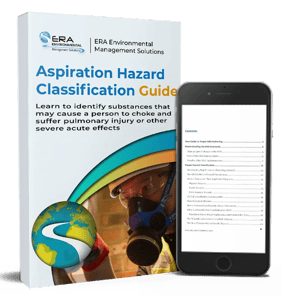ERA's GHS Purple Book Educational Guides

Acute Toxicity
Do you struggle to understand GHS chemical classifications?
ERA experts have put together this guide outlining the determination of Acute Toxicity Categories for your chemicals. If you work with SDS for health and safety or environmental reporting purposes, knowing this method will save you time and ensure that you have accurate chemical information.

Carcinogenicity
Short-term and long-term exposure to carcinogenic substances can increase your employees' risk of occupational cancer.
Accurately identify carcinogens in your facility and provide your employees with the necessary precautions by following the guidelines in this eBook. You will receive all the information in the UN's "Purple Book" for only a fraction of the pages.

Aspiration Hazard
Learn to classify these chemicals on the basis of available scientific evidence and their kinematic viscosity values by reading our concise, 20-page guide, free of charge!

Germ Cell Mutagenicity
Germ cell mutagens can have lasting effects on the offspring of people exposed to them, so companies and facilities making use of these chemicals are required to follow the appropriate labeling criteria.
Read our concise guide for the essentials on germ cell mutagenicity, including determining the effect on humans from classification studies and using the appropriate label.

Reproductive Toxicity
Chemicals known, presumed, or suspected to have adverse effects on the sexual function and fertility of adults or the development of offspring are considered reproductive toxicants.
With our 22-page guide, you will be able to classify these substances, evaluate scientific studies using the weight of evidence approach, and determine which label to use.

STOT - Single Exposure
Specific Target Organ Toxicity, an umbrella term encompassing the non-lethal effects (targeting specific organs) that are not covered by the other Purple Book Health Hazards, can be hard to identify.
Read our comprehensive guide for all the classification principles and guidance values required to classify substances leading to health hazards after single exposure.

STOT - Repeated Exposure
Specific Target Organ Toxicity, an umbrella term encompassing the non-lethal effects (targeting specific organs) that are not covered by the other Purple Book Health Hazards, can be hard to identify.
Read our comprehensive guide for all the classification principles and guidance values required to classify substances leading to health hazards after repeated exposure.

Eye Damage and Irritation
A wide variety of chemical substances may produce changes in human eyes accidentally exposed to them, up to and including serious, not fully reversible physical decay in a person's vision.
If you work with Safety Data Sheets, our 24-page guide will save you time and money and ensure you accurately classify eye damaging and eye irritating substances.

Skin Corrosion and Irritation
However, finding the information you need can be a challenge. That’s why ERA experts have prepared this 24-page guide to save you time and ensure accuracy.

Skin or Respiratory Sensitization
ERA’s experts have prepared a 25-page guide with the key details you need to address these hazards. Take the right approach to health & safety for your facility with this free guide.

Acute Aquatic Toxicity
While the GHS and CLP group all types of toxic effects on aquatic ecosystems under a single Aquatic Toxicity hazard class, we have separated them into two individual eBooks for ease of classification.
This A to Z guide is 30 pages long and covers everything there is to know about short-term, acute aquatic toxicity classification for hazardous substances and mixtures.

Chronic Aquatic Toxicity
While the GHS and CLP group all types of toxic effects on aquatic ecosystems under a single Aquatic Toxicity hazard class, we have separated them into two individual eBooks for ease of classification.
This A to Z guide is 34 pages long and covers everything there is to know about long-term, chronic aquatic toxicity classification for hazardous substances and mixtures.

Flammable Liquids
Substances and mixtures with flash points at or below 93 degrees Celsius may have to be classified as flammable liquids. Determining the flash point and which classification are relevant, however, is a more complicated process.
Read our 17-page, straight-to-the-point guide written by ERA experts for all the information you need to identify and classify flammable liquids.
©2025 ERA Environmental, Inc. All rights reserved. Privacy Policy